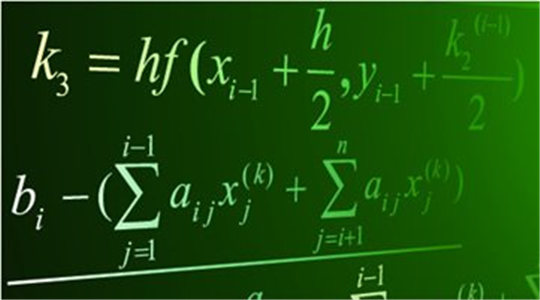
当前课程知识点:微积分-2 > Chapter 4 Differentiations of Multivariable Functions 多元函数微分学 (third part) > Unit 6 Partial Derivatives and Differentiability (偏导数与可微性) (section 3) > Partial Derivatives and Differentiability (偏导数与可微性) (section 3)
Section 3.
Differentiability 可微性
好的 同学们
刚才我们介绍了我们要利用
一元时候定义连续性 可微性的思想
来定义多元的可微性
我们用的方法是
引入无穷小量和无穷小量的比阶
那么下面呢我们把这些过程明确一下
Let us consider first
the differentiability of a 2-variable function
我们先看简单情况
就是两个变量的情况
怎么定义可微性
Definition 3.1
Suppose that f=f(x,y) is defined
near some point a which is (a,b)
二元的时候呢我们假设自变量是x,y
然后某个特定的点a
它的分量是(a,b)
It is said to be differentiable at this point
我们称这个函数f在a这个点是可微的
如果存在
if there exists some A
注意这个是大写的A
大写A表示一个向量
它的向量两个分量是(λ, μ)
它呢看成一个二维的向量 好的
如果存在这样一个向量
使得底下这个式子
f(a+Δ) 这个Δ是变化
它也是一个二维向量
等于
f(a) plus the inner product of big A with Δ
and then plus o(Δ)
这个就是我们前面的思想
如果f在一个点a处
它的变化可以用常数项f(a)再加上一阶项
就是A和Δ的内积这个形式表达出来
剩下是高阶项的话
我们就称是可微的
这个式子也可以写成下面这个样子
也就是把内积写开
它就是f(a)加上内积项是λ乘以Δx加上μ乘以Δy
因为Δ有两个分量分别是Δx Δy
最后还是高阶项o(Δ)
如果这件事情是对的
我们就称
f is differentiable at this point
这样我们定义了什么是可微性
In such a case
the vector A we found is called the gradient of f at a
就像我们前边一元的时候
找到那个常数叫做f的导数
现在我们找到是一个二维的向量大A
这个大A 通常我们不叫导数了
把它叫做gradient梯度
这个梯度啊
有特殊的符号同学们仔细看一下
把它记成 注意这是个倒写的三角形f
然后再写它的那个点就是a处
这个倒写的三角形f念成什么呢
念成nabla f
nabla f means the gradient of f
它可以这样写先写nabla f
再画一个小括号a
也可以这样写
写成什么呢
这种有点像这个偏导数的样子
但是不要和偏导数混淆
上面是
partial f底下是
partial(x,y)
要加括号
强调的是关于两个变量的同时的这个
求这个gradient
所以要这样写 好的
那么它的结果当然就是我们这个大写的A
这个向量 就是(λ,μ)
可见通过无穷小量我们的确可以定义什么是
differentiability
可微性以及所导出的这个二维的导数
也就是梯度这个概念
So in 2-dimensional case
nabla f plays the role of derivatives of functions
所以我们要记住啊
二维以上的函数它们的导数叫梯度
梯度是向量
下边 二元的情况清楚了
我们来讨论n元的情况
we define the differentiability of n-variable functions
请看
Definition 3.2
这个定义和二元的情况是完全类似的
Suppose that f is a function of x1 to xn
defined near a
it is said to be differentiable at this point a
if there exists some A
这个大写的A是一个向量
它的分量是α1 to αn
and it's again a vector in E^n such that
f(a+Δ)=f(a) plus the inner product of A with Δ plus o(Δ)
写开了就是f(a)加上α1乘以Δx1
加上...再加上αn乘以Δxn
再加上高阶项o(Δ)
这里的这个Δ就是变量Δ
它实际上是由很多分量Δx1一直到Δxn组成的
这就是可微性的定义
如果这个可微性这个条件成立的话
In such a case the vector
就是前面这个向量大写的A
叫做f这个n元函数在a点的gradient梯度
好这个时候呢 我们的记号
也就是梯度记号和我们二元的记号是一样的
written as nabla f在a处
or nabla f at this point a
or 这种记法也会见到
就是用偏导数的记法
上面是partial f
底下是partial
然后画一个括号x1到xn
这都是梯度的记法
当然它的结果实际上就是我们刚才那个向量A
就是α1到αn这个向量
so in n-dimensional case the vector
nabla f plays the role of derivatives of functions
同样的
n元函数的梯度实际上相当于n元函数的导数
同学们 前面我们已经明确了偏导数
刚才又定义了可微性
那偏导数和可微性到底什么关系呢
这就是我们下面要讲的内容
What is the relationship
between differentiability and partial derivatives
这也是难点之一 同学们一定要认真听讲啊
我们看这个定理怎么说它说
if f=f(x,y) is differentiable at this point
假设我们现在考虑这个二元函数f等于f(x,y)
它在某个点a处可微
也就是说它的梯度存在
假设它的梯度nabla f等于(λ,μ)在这个点
在这个条件下 我们就有
λ equlas这是什么
这是偏导数
partial f over partial x at a
这个等式意思是说
如果我们已经知道f在这个点a处可微了
那么它的梯度的第一个分量
就是f关于第一个分量x的偏导数
类似的f关于y的偏导数
恰好的梯度的第二个分量
于是这个定理告诉我们可微意味着偏导数一定存在
而且可微导数的那个梯度一定就是由偏导数构成的
In other words if it exists one has nabla f equals
nabla f我们有两种记号
注意 既可以写成nabla f
也可以写成偏f除以偏(x,y)
它一定就是偏f
partial x partial f partial y
这个样子 换句话说
可微则偏导数一定存在
把偏导数排起来就恰好是梯度
刚才这个命题啊 其实证明非常简单
不妨看一下
比如说假设这个点a就是(a,b)两个分量
那么我们计算一下
这一个偏导数
比如说求偏f/偏x
按定义它就是这个极限式
分子是
f(a+h,b)-f(a,b)再除以h
然后再求极限
极限的过程是h趋近于0的
那么根据可微性
也就是我们已经假设f是可微的
直接就可以把f(a+h,b)写成
梯度乘以变量然后再加上高阶项的样子
最后剩下的项就是λh+o(h)
这个同学们自己把它展开写一下
那么求这个极限最后的结果
很容易看出来
因为这里头全是h的项
所以呢 最后求极限恰好等于λ
这就是梯度第一个分量
那类似的呢
我们可以证明偏f/偏y在a处一定等于μ
这样就证明了这个命题
so we see that f=f(x,y) is differentiable implies
the existence of partial derivatives
所以可微意味着偏导数的存在
但是偏导数存在通常不意味着可微
这个我们后面再解释
Similar facts hold true for n-variable functions as well
就是n元函数的时候也有类似的情况
可微一定偏导数都存在
However existence of all the partial derivatives
does not imply differentiability
也就是偏导数都存在
不见得函数一定是可微的
下面我们看一个例子来说明这个
比如说现在这个函数
很特殊的一个函数
f(x,y)定义成根号下绝对值xy
那么在a这个点就是(0,0)点
我们来看一下
首先我们可以断定
它两个偏导数都存在而且都等于0
这个呢是直接用偏导数的定义套进去就可以证明的
我们这个地方呢就省略了这个证明过程
因为它需要用偏导数的定义
而且比较细致
同学们自己呢
仔仔细细地推导一下
我们看到两个偏导数都存在
但是f这个特殊的函数
它实际上在(0,0)点是不可微的
f is not differentiable at this point
为什么呢 实际上
我们可以说明f为什么一定不可微
反过来 假设f可微了 会怎样呢
如果f可微了
那么按定义我们就可以把刚才这个函数
写成这个样子
也就是f如果变量是(Δx,Δy)的话
它就一定要等于0乘以Δx加上0乘以Δy
再加上一个高阶项
就是小o里边实际上是Δ的norm
也就是根号下Δx平方加Δy平方
这是按可微性定义写出来的
那么我们看看这意味着什么
但是 我们知道根号下Δx乘以Δy就是f
那么刚才这个式子意味着
根号下ΔxΔy的绝对值呢要等于小o(norm of Δ)
也就是小o根号下Δx平方加Δy平方了
这个实际上是不可能的
which is certainly wrong
因为啊 我们把上面这个式子换一个写法就是
极限Δ趋近于0的时候根号下ΔxΔy
除以根号下Δx平方加Δy平方要趋近于0
这实际上这个极限呢是不存在的
因此这是一定不对的
这里呢同学们一定要仔仔细细思考一下
为什么这个极限不存在
其实很简单
我们只要用以前学过的判定极限是否存在的方法
选定某两个方向就可以看出来了
同学们
在一元函数的时候 我们知道可导和可微是一样的
也就是说有导数就可微 可微就有导数
但是呢 在多元函数是不一样的
偏导数存在不见得可微
但是可微呢一定保证偏导数的存在
好 下面呢我们看另外一个定理来说明额外的情况
如果f是一个函数
它定义在n维的欧几里德空间E^n中的某个区域D上
然后呢a又是这个区域的一个内点
interior point
alright 好的 下面我们来看
If 它条件这么说
all the partial f/partial xi
也就是所有的这个偏导数
都存在而且是在a点的邻近
附近的一个区域内全部都存在
each partial f/partial xi exists near a
and each partial f/partial xi
is continuous at this point a
而且每一个偏导数在a点处都是连续的
则我们就可以断定
f is differentiable at this point a
这相当于刚才这种情况的反过来
也就是说偏导数在什么情况下能够保证可微性
那么这个定理告诉我们答案
偏导数要在这个点的附近都存在
而且偏导数要在这个点连续
那么就能保证f在该点的连续性
所以我们看到可微性和偏导数存在性之间是有关联的
这个定理就告诉我们在什么情况下
它们两者之间实际上是互相都存在的
那么下面我们还有一个注记
The converse of the above is not true
刚才这个定理实际上是很强的
也就是说
In other words even if we know that f
say two-variable function
假设我们现在考虑的是一个二元函数
which is differentiable at this point
a and partial f/partial x
partial f/partial y all exists near a
即便是我们知道f在某个点a处是可微的
那么它两个偏导数在那个点存在
我们又假设 它的两个偏导数在那个点的附近都存在
we can not conclude that
partial f/partial x and partial f/partial y
are continuous at this point
我们并不能够导出这个函数的偏导数
它一定连续 这是导不出来的
不妨看一个例子
我们现在考虑这个例子
f(x,y) equals
它分两种情况
如果xy中至少有一个不等于0
就定义成x^2+y^2乘以sin(1/(x^2+y^2))
如果xy同时等于0则定义成0
这个函数定义呢
是在整个平面上
我们下面考虑在0点的可微性和偏导数的情况
首先 我们断定f一定是可微的 在0点
这个是很容易的
另外我们还要注意到它的偏导数是可以被算出来的
这个计算过程呢我们就不在屏幕上做了
同学们一定要在草稿纸上认真计算一下
算出来结果是这样的
还是分两种情况
一种是xy中至少有一个不等于0
一个是xy同时等于0
我们把解析式已经解出来了
同学们认真地验算一下
注意现在我们得到的这个
f的偏导数在0点的附近都存在
但是它在0处实际上是不连续的
this partial f/partial x is not continuous at (0,0)
为什么呢
请同学们看一下表达式就看出来了
因为这个partial f/partial x的表达式的上半部分
也就是我们现在看到的这个花括号右边上半部分
里边有一项 哪一项呢
就是2x/(x^2+y^2)乘以cos(1/(x^2+y^2))这一项啊
在(0,0)处它极限实际上是不存在的
因为分子的次数是1
分母的次数x^2+y^2比1的次数要高
同学们一定要想清楚为什么它的极限不存在
总之这个例子就告诉我们偏导数在一个点的
附近的邻域都存在
但是呢并不在那个点连续
总之呢今天我们讲了很多很多各种各样的关系
我们现在呢不妨给同学们稍微总结一下
就是各阶偏导数连续
能够保证函数的可微性
函数可微性能够保证
各方向偏导数在某个点存在性
各方向偏导数的存在
并不能保证函数的连续性
那更不用说函数的可微性
总之呢 我们可以
画这么一张图来大概理解一下它们的关系
同学们还是要把每一个细节想清楚
尤其是这些例子看懂 就明白了
同学们 以上就是这一讲的全部内容
我们学习了多元函数的偏导数
梯度 可微性等等概念
我们要注意啊
多元函数偏导数的存在性
和它的可微性并不是等价的
这是多元函数与一元函数的一个显著区别
希望同学们能够课下再复习一下这些内容
理解这些关系
在下一讲中呢
我们将学习多元函数的雅可比矩阵以及方向导数
同学们呢一定要提前预习一下
好的 我们下节课 再见
-Introduction (课程介绍)
-Unit 1 Definition of Improper Integrals (广义积分的定义)(section 1)
--Definition of Improper Integrals (广义积分的定义)(section 1)
--Exercises-1-1-1
-Unit 1 Definition of Improper Integrals (广义积分的定义)(section 2)
--Definition of Improper Integrals (广义积分的定义)(section 2)
--Exercises-1-1-2
-Unit 2 Examples of Improper Integrals (广义积分的例子)
--Video-1-2 Examples of Improper Integrals (广义积分的例子)
--Exercise-1-2
- Unit 3 Tests of Convergence(收敛性判别)(section 1)
--Tests of Convergence(收敛性判别)(section 1)
--Exercises-1-3-1
- Unit 3 Tests of Convergence(收敛性判别)(section 1)--作业
- Unit 3 Tests of Convergence(收敛性判别)(section 2)
--Tests of Convergence(收敛性判别)(section 2)
--Exercises-1-3-2
- Unit 3 Tests of Convergence(收敛性判别)(section 2)--作业
-Unit 4 Absolute Convergence and Conditional Convergence (绝对收敛和条件收敛)
--Absolute Convergence and Conditional Convergence (绝对收敛和条件收敛)
--Exercise-1-4
--1-4讲义
-Test1
-Unit 1 Infinite Series and Their Convergence(无穷级数及其收敛性)
--Infinite Series and Their Convergence (无穷级数及其收敛性)
--Exercises-2-1
--2-1讲义
-Unit 2 Absolute Convergence and Conditional Convergence (绝对收敛与条件收敛)
--Absolute Convergence and Conditional Convergence (绝对收敛与条件收敛)
--Exercises-2-2
--2-2讲义
-Unit 3 More Tests for Convergence (更多的收敛性判别法)(section 1)
--More Tests for Convergence (更多的收敛性判别法)(section 1)
--Exercises-2-3-1
-Unit 3 More Tests for Convergence (更多的收敛性判别法)(section 2)
--More Tests for Convergence (更多的收敛性判别法)(section 2)
--Exercises-2-3-2
-Unit 3 More Tests for Convergence (更多的收敛性判别法)(section 3)
--More Tests for Convergence (更多的收敛性判别法)(section 3)
--Exercises-2-3-3
--2-3讲义
-Test2
-Unit 4 Sequences and Series of Founctions(函数项数列与函数项级数)(section 1)
--Sequences and Series of Founctions(函数项数列与函数项级数)(section 1)
--Exercises-2-4 (section 1)
-Unit 4 Sequences and Series of Founctions(函数项数列与函数项级数)(section 2)
-- Sequences and Series of Founctions(函数项数列与函数项级数)(section 2)
--Exercises-2-4 (section 2)
--2-4讲义
-Unit 5 Uniform Convergence(一致收敛性)(section 1)
--Uniform Convergence(一致收敛性)(section 1)
--Exercises-2-5(section 1)
-Unit 5 Uniform Convergence(一致收敛性)(section 2)
--Uniform Convergence(一致收敛性)(section 2)
--Exercises-2-5(section 2)
--2-5讲义
-Unit 1 Power Series (幂级数)(section 1)
--Power Series (幂级数) (section 1)
--Exercise-3-1(section 1)
-Unit 1 Power Series (幂级数)(section 2)
--Power Series (幂级数)(section 2)
--Exercise-3-1 (section 2)
--3-1讲义
-Unit 2 Expansion of Functions in Power Series (函数的幂级数展开)
--Expansion of Functions in Power Series(函数的幂级数展开)
--Exercise-3-2
--3-2讲义
-Unit 3 Fourier Expansion (Fourier级数展开) (section 1)
--Fourier Expansion(Fourier级数展开)(section 1)
--Exercise-3-3(section 1)
-Unit 3 Fourier Expansion (Fourier级数展开) (section 2)
--Fourier Expansion(Fourier级数展开)(section 2)
--Exercise-3-3(section 2)
--3-3讲义
-Unit 4 Convergence of Fourier Series(Fourier 级数的收敛性)(section 1)
--Convergence of Fourier Series(Fourier 级数的收敛性)(section 1)
--Exercise-3-4(section 1)
-Unit 4 Convergence of Fourier Series(Fourier 级数的收敛性)(section 2)
--Convergence of Fourier Series(Fourier 级数的收敛性)(section 2)
--Exercise-3-4(section 2)
--3-4讲义
-Unit 5 Other Forms of Fourier Series(其他形式的Fourier级数)
--Other Forms of Fourier Series(其他形式的Fourier级数)
--Exercise-3-5
--Test3
--3-5讲义
-Unit 1 Euclidean Space (欧几里德空间) (section 1)
--Euclidean Space (欧几里德空间) (section 1)
--Exercise-4-1-1
-Unit 1 Euclidean Space (欧几里德空间) (section 2)
--Euclidean Space (欧几里德空间) (section 2)
--Exercise-4-1-2
-Unit 1 Euclidean Space (欧几里德空间) (section 3)
--Euclidean Space (欧几里德空间) (section 3)
--Exercise-4-1-3
--4-1讲义
-Unit 2 Curves and Surfaces (曲线与曲面) (section 1)
--Curves and Surfaces (曲线与曲面) (section 1)
--Exercise-4-2-1
-Unit 2 Curves and Surfaces (曲线与曲面) (section 2)
--Curves and Surfaces (曲线与曲面) (section 2)
--Exercise-4-2-2
-Unit 2 Curves and Surfaces (曲线与曲面) (section 3)
--Curves and Surfaces (曲线与曲面) (section 3)
--4-2讲义
-Unit 3 Point-Set Topology of E3 (E3中的点集拓扑) (section 1)
--Point-Set Topology of E3 (E3中的点集拓扑) (section 1)
--Exercise-4-3-1
-Unit 3 Point-Set Topology of E3 (E3中的点集拓扑) (section 2)
--Point-Set Topology of E3 (E3中的点集拓扑) (section 2)
--Exercise-4-3-2
-Unit 3 Point-Set Topology of E3 (E3中的点集拓扑) (section 3)
--Point-Set Topology of E3 (E3中的点集拓扑) (section 3)
--Exercise-4-3-3
--4-3讲义
-Unit 4 Completeness and Connectness (完备性与连通性) (section 1)
--Completeness and Connectness (完备性与连通性) (section 1)
--Exercise-4-4-1
-Unit 4 Completeness and Connectness (完备性与连通性) (section 2)
--Completeness and Connectness (完备性与连通性) (section 2)
--Exercise-4-4-2
--4-4讲义
-Unit 5 Continuous Multivariable Functions (连续多元函数) (section 1)
--Continuous Multivariable Functions (连续多元函数) (section 1)
--Exercise-4-5-1
-Unit 5 Continuous Multivariable Functions (连续多元函数) (section 2)
--Continuous Multivariable Functions (连续多元函数) (section 2)
--Exercise-4-5-2
-Unit 5 Continuous Multivariable Functions (连续多元函数) (section 3)
--Continuous Multivariable Functions (连续多元函数) (section 3)
--Exercise-4-5-3
--4-5讲义
-Unit 6 Partial Derivatives and Differentiability (偏导数与可微性) (section 1)
--Partial Derivatives and Differentiability (偏导数与可微性) (section 1)
--Exercise-4-6-1
-Unit 6 Partial Derivatives and Differentiability (偏导数与可微性) (section 2)
--Partial Derivatives and Differentiability (偏导数与可微性) (section 2)
--Exercise-4-6-2
-Unit 6 Partial Derivatives and Differentiability (偏导数与可微性) (section 3)
--Partial Derivatives and Differentiability (偏导数与可微性) (section 3)
--Exercise-4-6-3
--4-6讲义
-Unit 7 Jacobian Matrix and Directional Derivatives (雅克比矩阵与方向导数) (section 1)
--Jacobian Matrix and Directional Derivatives (雅克比矩阵与方向导数) (section 1)
-Unit 7 Jacobian Matrix and Directional Derivatives (雅克比矩阵与方向导数) (section 2)
--Jacobian Matrix and Directional Derivatives (雅克比矩阵与方向导数) (section 2)
--Exercise-4-7-1
--Exercise-4-7-2
-Unit 7 Jacobian Matrix and Directional Derivatives (雅克比矩阵与方向导数) (section 3)
--Jacobian Matrix and Directional Derivatives (雅克比矩阵与方向导数) (section 3)
--Exercise-4-7-3
-Unit 7 Jacobian Matrix and Directional Derivatives (雅克比矩阵与方向导数) (section 4)
--Jacobian Matrix and Directional Derivatives (雅克比矩阵与方向导数) (section 4)
--Exercise-4-7-4
--4-7讲义
-Test1
-Unit 8 Taylor's Theorem (泰勒定理) (section 1)
--Taylor's Theorem (泰勒定理) (section 1)
-Exercise-4-8-1
-Unit 8 Taylor's Theorem (泰勒定理) (section 2)
--Taylor's Theorem (泰勒定理) (section 2)
-Exercise-4-8-2
-Unit 8 Taylor's Theorem (泰勒定理) (section 3)
--Taylor's Theorem (泰勒定理) (section 3)
--4-8讲义
-Unit 8 Taylor's Theorem (泰勒定理) (section 3)--作业
-Unit 9 Applications of Gradients (梯度的应用) (section 1)
--Applications of Gradients (梯度的应用) (section 1)
-Unit 9 Applications of Gradients (梯度的应用) (section 2)
--Applications of Gradients (梯度的应用) (section 2)
--Exercise-4-9-2
--4-9讲义
-Unit 1 Multiple Integrals (重积分) (section 1)
--Multiple Integrals (重积分) (section 1)
-Unit 1 Multiple Integrals (重积分) (section 2)
--Multiple Integrals (重积分) (section 2)
--Exercise-5-1-2
-Unit 1 Multiple Integrals (重积分) (section 3)
--Multiple Integrals (重积分) (section 3)
--Exercise-5-1-3
--5-1讲义
-Unit 2 Triple Integrals (三重积分) (section 1)
--Triple Integrals (三重积分) (section 1)
--Exercise-5-2-1
-Unit 2 Triple Integrals (三重积分) (section 2)
--Triple Integrals (三重积分) (section 2)
--Exercise-5-2-2
-Unit 2 Triple Integrals (三重积分) (section 3)
--Triple Integrals (三重积分) (section 3)
--Exercise-5-2-3
--5-2讲义
-Unit 3 Line Integrals (曲线积分) (section 1)
--Line Integrals (曲线积分) (section 1)
--Exercise-5-3-1
-Unit 3 Line Integrals (曲线积分) (section 2)
--Line Integrals (曲线积分) (section 2)
--Exercise-5-3-2
--5-3讲义
-Unit 4 Surface Integrals (I) (第一型曲面积分) (section 1)
--Surface Integrals (I) (第一型曲面积分) (section 1)
--Exercise-5-4-1
-Unit 4 Surface Integrals (I) (第一型曲面积分) (section 2)
--Surface Integrals (I) (第一型曲面积分) (section 2)
--Exercise-5-4-2
-Unit 4 Surface Integrals (I) (第一型曲面积分) (section 3)
--Surface Integrals (I) (第一型曲面积分) (section 3)
--Exercise-5-4-3
-Unit 5 Surface Integrals (II) (第二型曲面积分) (section 1)
--Surface Integrals (II) (第二型曲面积分) (section 1)
-Unit 5 Surface Integrals (II) (第二型曲面积分) (section 2)
--Surface Integrals (II) (第二型曲面积分) (section 2)
--5-4讲义
-Unit 5 Surface Integrals (II) (第二型曲面积分) (section 3)
--Surface Integrals (II) (第二型曲面积分) (section 3)
--Exercise-5-5-1
--5-5讲义
-Unit 6 Some Theorems of Line and Surface Integrals (曲线与曲面积分的几个定理) (section 1)
--Some Theorems of Line and Surface Integrals (曲线与曲面积分的几个定理) (section 1)
--Exercise-5-6-1
-Unit 6 Some Theorems of Line and Surface Integrals (曲线与曲面积分的几个定理) (section 2)
--Some Theorems of Line and Surface Integrals (曲线与曲面积分的几个定理) (section 2)
-Unit 6 Some Theorems of Line and Surface Integrals (曲线与曲面积分的几个定理) (section 3)
--Some Theorems of Line and Surface Integrals (曲线与曲面积分的几个定理) (section 3)
--Exercise-5-6-2
--Exercise-5-6-3
--5-6讲义
-Unit 6 Some Theorems of Line and Surface Integrals (曲线与曲面积分的几个定理) (section 4)
--Some Theorems of Line and Surface Integrals (曲线与曲面积分的几个定理) (section 4)
-Unit 7 Field Theory (场论) (section 1)
--Field Theory (场论) (section 1)
-Unit 7 Field Theory (场论) (section 2)
--Field Theory (场论) (section 2)
--Exercise-5-7-1
-Unit 7 Field Theory (场论) (section 3)
--Field Theory (场论) (section 3)
-Unit 7 Field Theory (场论) (section 4)
--Field Theory (场论) (section 4)
--Exercise-5-7-2
--Test5
--5-7讲义


